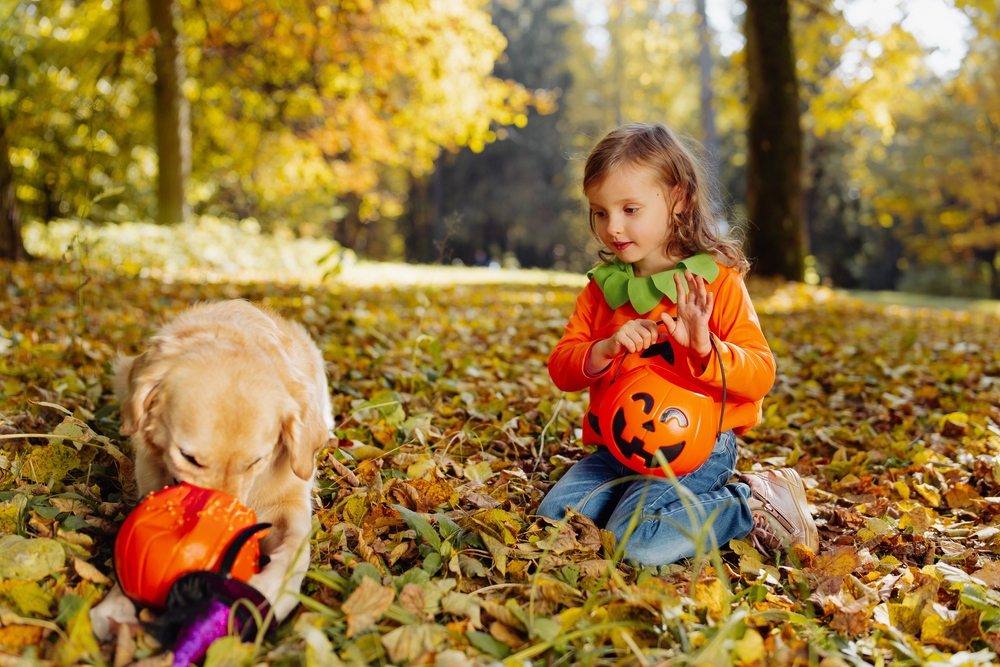Halloween Safety—Pet Tales From the Crypt

Halloween is many people’s favorite holiday, but all the frights are more than make-believe for your pet—they can be hazardous. Our team at Bayside Animal Hospital wants to help you keep your pet safe when the ghosts and ghouls come out to play. We’ve enlisted some experts to offer Halloween safety advice.
Barb the black cat says, “Keep your pet inside on Halloween night. The neighborhood is full of scary creatures and mischievous rascals.”
Bayside Animal Hospital (BAH): Barb speaks from experience. Black cats are especially targeted during the Halloween revelries. Ensure your pet stays inside, to prevent anyone from playing malicious pranks, and to ensure they don’t get spooked and run away. Walk your dog before the sun sets, so they aren’t exposed to the nighttime activities. If the trick-or-treaters in your neighborhood are loud or rowdy, sequester your pet in a quiet inner room in your home, so they don’t become frightened or stressed.
Harold the husky says, “Get your pet microchipped. I love to roam free, but I don’t like getting lost, especially when zombies and vampires have invaded my neighborhood.”
BAH: Huskies are notorious for their strong wanderlust, but any pet can become lost if they are spooked by strangely dressed figures. Microchipping your pet is an easy way to ensure they are permanently identified, and we can perform this simple procedure at their next wellness visit. Your pet should also wear identification tags with your current contact information, so your neighbors know who to call if they find your wayward pet.
Daryl the dachshund says, “Don’t make your pet wear a costume. My owner thinks having me dress up as a hotdog is hilarious, but I find the situation mortifying.”
BAH: Many pets find costumes upsetting and stressful. If your pet is more easygoing, ensure they are comfortable wearing the costume by gradually increasing the time they spend in the outfit before Halloween night. Also, ensure their costume fits well, and does not rub or pinch, or inhibit their breathing or mobility. If the costume has a head or neck piece, ensure your pet’s vision and hearing are not impeded.
Simone the Sphinx cat says, “Choose pet-friendly decorations. I got quite the shock last year when I was investigating my owner’s electric light display.”
BAH: Many cats are compelled to chew electric cords. If you decorate with lights, ensure the cords are well hidden, so your cat is not tempted to bite. Other decorations that can be dangerous include:
- Lit candles — A frisky paw swipe, or an oblivious tail wag, can knock over a candle, burning your pet, or setting a fire.
- Automated characters — Moving monsters may upgrade your Halloween decor, but these characters can cause your pet to panic and bolt. Also, some pets may feel threatened by the monsters, and become aggressive.
- Small knick knacks — Placing small decorations, such as glass eyeballs, fabric spiders, and plastic skulls, around your home can help you get in the Halloween spirit. However, these objects could cause a gastrointestinal obstruction in your pet, requiring surgical removal.
Lenny the Labrador says, “Don’t let your pet raid your candy stash. I got a bad tummy ache when I looted my owner’s trick-or-treat goodies.”
BAH: Luckily, Lenny recovered from his dietary indiscretion, but your pet may not be so fortunate, if they raid your candy supply. Dangers include:
- Candy wrappers — Ingested plastic and foil wrappers can cause a gastrointestinal obstruction.
- Hard candies — Small hard candies can become a choking hazard.
- Chocolate — The theobromine and caffeine in this sweet treat cause central nervous system stimulation in pets. Signs include agitation, restlessness, vomiting, and diarrhea.
- Sugar-free candies — Many sugar-free candies contain xylitol, which causes a dose-dependent insulin release in pets. This leads to a profound drop in blood sugar, resulting in incoordination, weakness, and seizures.
- Raisins — Grapes and raisins contain an unknown toxin that causes kidney failure in pets.
- Nuts — All nuts are high in fat and can cause gastrointestinal upset. Macadamia nuts are especially dangerous for pets, causing vomiting, ataxia, weakness, and hyperthermia.
Steve the Siamese cat says, “Don’t let your pet partake in the party fare. I had to spend a night in the hospital after nibbling on an hors d’oeuvre.”
BAH: We are glad that Steve is doing well now, and we don’t want your pet to end up in the emergency room after your Halloween party. Avoid these party treats:
- Onions and garlic — These tasty vegetables contain thiosulphates, which attach to your pet’s red blood cells, causing them to break down, and leading to anemia. Initial signs include lethargy, vomiting, and diarrhea.
- Alcohol — Spiking the punch bowl can liven up the party, but pets are extremely alcohol-sensitive. Signs include incoordination, vomiting, disorientation, diarrhea, and seizures.
- Nutmeg — Pumpkin spice goodies are a favorite during Halloween festivities, but nutmeg can cause gastrointestinal upset, and in severe cases, disorientation and seizures in pets.
Follow our Halloween experts’ advice, and keep your pet safe and sound for the spooktacular evening. If you would like your pet microchipped in preparation for the upcoming event, contact our team at Bayside Animal Hospital, to schedule an appointment.


